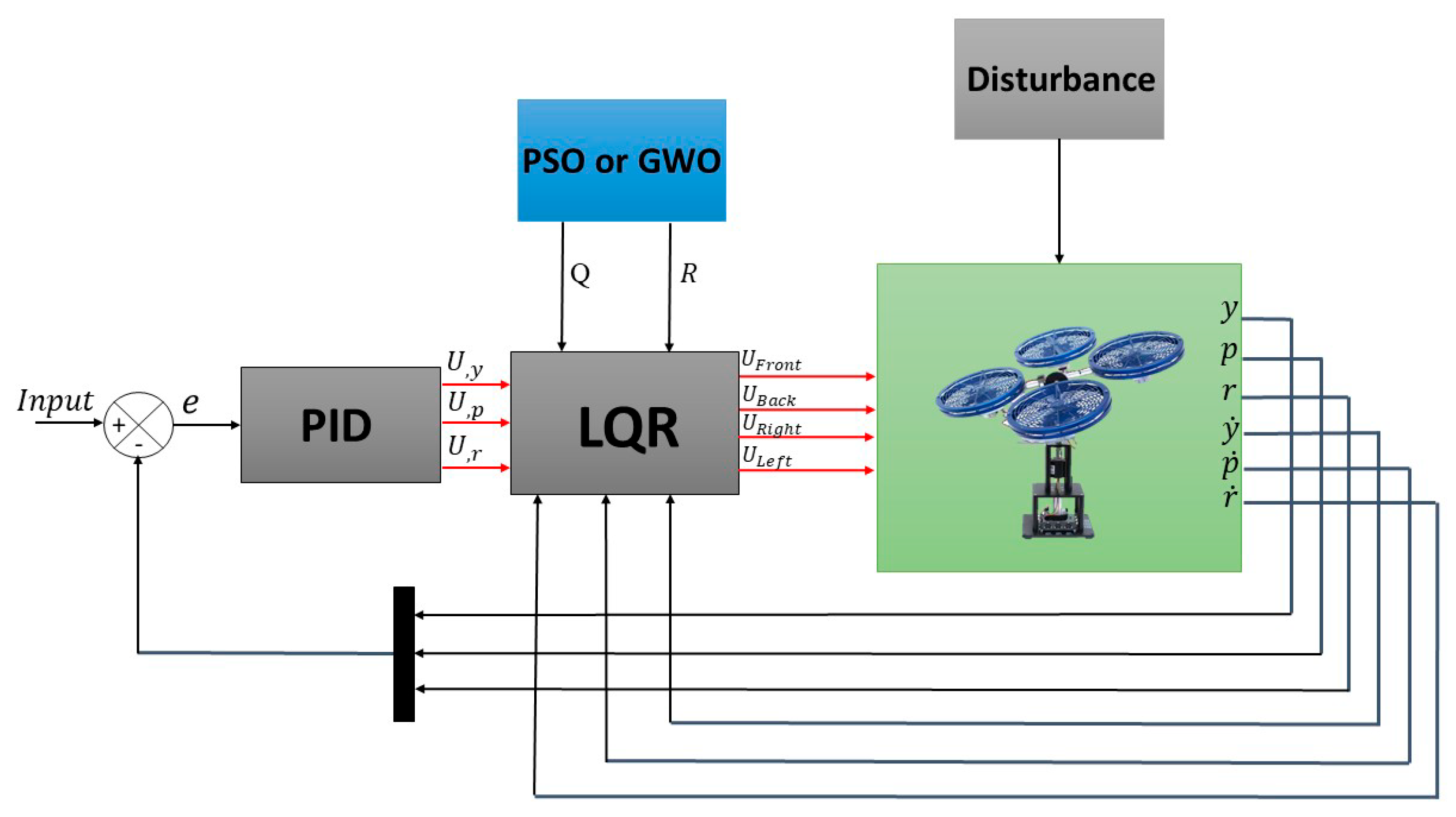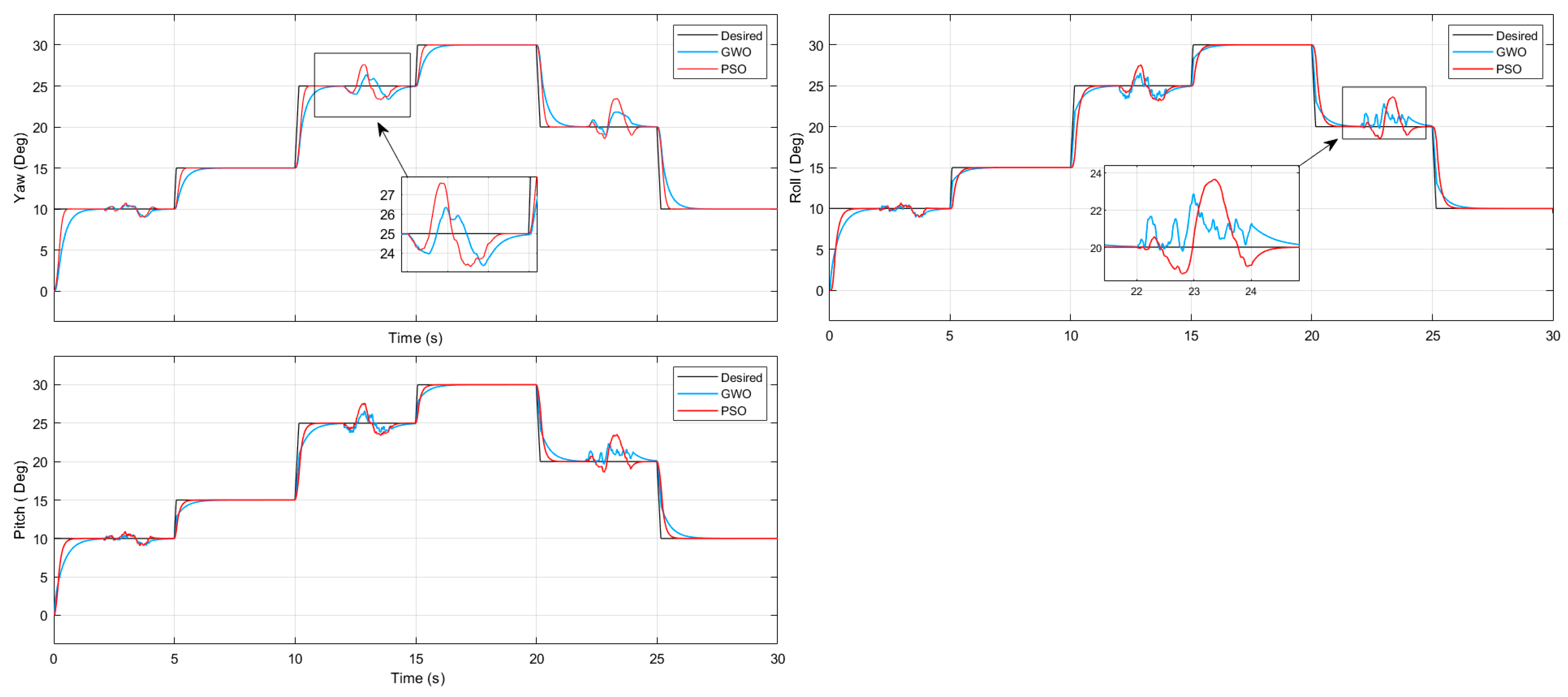Robustness Analysis of LQR-PID Controller Based on PSO and GWO for Quadcopter Attitude Stabilization †
Abstract
1. Introduction
2. Quadcopter Dynamic Model and Mathematical Formulation
3. Proposed Control Approach
3.1. LQR-PID Controller
3.2. PSO Optimization for LQR Controller
3.2.1. Initialization
- Define a population of particles, each representing potential values for the elements of matrices Q and R.
- Initialize particle velocities and positions randomly within predefined bounds.
3.2.2. Fitness Evaluation
- For each particle, compute the corresponding gain matrix K using the LQR design equations.
- Simulate the closed-loop system’s response with the computed K.
- Evaluate the performance using a cost function J, typically defined as (9).
3.2.3. Update Personal and Global Bests
- Track the best position (Q and R values) each particle has achieved (personal best).
- Identify the overall best position found by any particle (global best).
3.2.4. Velocity and Position Update
- Update each particle’s velocity and position using the following:
- is the current velocity of particle ;
- is the inertia weight;
- and are personal and social acceleration coefficients, respectively;
- and are random numbers between 0 and 1;
- is the personal best position of particle ;
- is the global best position.
3.2.5. Iteration
- Repeat the evaluation and update steps for a predetermined number of iterations or until convergence criteria are met.
- By iteratively adjusting Q and R through PSO, the LQR controller’s gain matrix K is optimized, leading to improved system performance in terms of stability and response characteristics.
3.3. GWO Optimization for LQR Controller
- Initialization: define an initial population of candidate solutions, each representing potential Q and R matrices. Assign hierarchical roles to the top candidates: alpha (α), beta (β), and delta (δ), with the remaining candidates designated as omega (ω).
- Position Update: update the positions of candidate solutions based on the positions of α, β, and δ, simulating the encircling and hunting behaviors of grey wolves.
- Evaluation: assess the fitness of each candidate by implementing the corresponding LQR controller and evaluating its performance using a predefined cost function.
- Hierarchy Update: rank the candidates based on their fitness scores and update their hierarchical roles accordingly.
- Iteration: repeat the position update and evaluation steps until convergence criteria are met or a specified number of iterations is reached.
- By iteratively refining the Q and R matrices through the GWO algorithm, the LQR controller’s performance can be optimized, leading to improved system stability and robustness.
4. Results and Discussion
4.1. Optimization Results
4.2. Trajectory Tracking and Robustness Analysis
5. Conclusions
Author Contributions
Funding
Institutional Review Board Statement
Informed Consent Statement
Data Availability Statement
Acknowledgments
Conflicts of Interest
References
- Sulila, M.S.; Riyadi, M.A. Particle swarm optimization (PSO)-based self tuning proportional, integral, derivative (PID) for bearing navigation control system on quadcopter. In Proceedings of the 2017 4th International Conference on Information Technology, Computer, and Electrical Engineering (ICITACEE), Semarang, Indonesia, 18–19 October 2017; IEEE: Piscataway, NJ, USA, 2017; pp. 181–186. [Google Scholar]
- Büyüker, Y.; İlhan, İ. Parameter Optimization of LQR Controller Applied to Three Degrees of Freedom System with Hybrid Approach. Konya J. Eng. Sci. 2024, 12, 494–510. [Google Scholar] [CrossRef]
- Benghezal, A.; Nemra, A.; Bouaziz, N.E.I.; Tadjine, M. New robust backstepping attitude control approach applied to quanser 3 DOF hover quadrotor in the case of actuators faults. Unmanned Syst. 2024, 12, 3–17. [Google Scholar] [CrossRef]
- Mohanty, S.; Misra, A. 3 DOF Autonomous Control Analysis of an Quadcopter Using Artificial Neural Network. In Modern Approaches in Machine Learning and Cognitive Science: A Walkthrough: Latest Trends in AI; Springer International Publishing: Cham, Switzerland, 2020; pp. 39–57. [Google Scholar]
- Hoffman, D.; Rehan, M.; MacKunis, W.; Reyhanoglu, M. Quaternion-based robust trajectory tracking control of a quadrotor hover system. Int. J. Control. Autom. Syst. 2018, 16, 2575–2584. [Google Scholar] [CrossRef]
- Bhattacharjee, D.; Subbarao, K. Robust control strategy for quadcopters using sliding mode control and model predictive control. In Proceedings of the AIAA Scitech 2020 Forum, Orlando, FL, USA, 6–10 January 2020; p. 2071. [Google Scholar]
- Alonge, F.; D’Ippolito, F.; Fagiolini, A.; Garraffa, G.; Sferlazza, A. Trajectory robust control of autonomous quadcopters based on model decoupling and disturbance estimation. Int. J. Adv. Robot. Syst. 2021, 18, 1729881421996974. [Google Scholar] [CrossRef]
- Thanh, H.L.N.N.; Hong, S.K. Quadcopter robust adaptive second order sliding mode control based on PID sliding surface. IEEE Access 2018, 6, 66850–66860. [Google Scholar] [CrossRef]
- Xie, W.; Cabecinhas, D.; Cunha, R.; Silvestre, C. Adaptive backstepping control of a quadcopter with uncertain vehicle mass, moment of inertia, and disturbances. IEEE Trans. Ind. Electron. 2021, 69, 549–559. [Google Scholar] [CrossRef]
- Yanez-Badillo, H.; Beltran-Carbajal, F.; Tapia-Olvera, R.; Favela-Contreras, A.; Sotelo, C.; Sotelo, D. Adaptive robust motion control of quadrotor systems using artificial neural networks and particle swarm optimization. Mathematics 2021, 9, 2367. [Google Scholar] [CrossRef]
- Betancourt-Vera, J.; Castillo, P.; Lozano, R.; Vidolov, B. Robust control scheme for trajectory generation and tracking for quadcopters vehicles: Experimental results. In Proceedings of the 2018 International Conference on Unmanned Aircraft Systems (ICUAS), Dallas, TX, USA, 12–15 June 2018; IEEE: Piscataway, NJ, USA, 2018; pp. 1118–1124. [Google Scholar]
- Kumar, E.V.; Raaja, G.S.; Jerome, J. Adaptive PSO for optimal LQR tracking control of 2 DoF laboratory helicopter. Appl. Soft Comput. 2016, 41, 77–90. [Google Scholar] [CrossRef]
- Ghiloubi, I.B.; Abdou, L.; Lahmar, O.; Dahnoun, I. 3 DOF Quanser’s Quadrotor Control Using LQR Based on PSO, FPA & ACO with Input Saturation. In Proceedings of the 2023 IEEE 11th International Conference on Systems and Control (ICSC), Sousse, Tunisia, 18–20 December 2023; IEEE: Piscataway, NJ, USA, 2023; pp. 790–795. [Google Scholar]
- Maghfiroh, H.; Nizam, M.; Anwar, M.; Ma’Arif, A. Improved LQR control using PSO optimization and Kalman filter estimator. IEEE Access 2022, 10, 18330–18337. [Google Scholar] [CrossRef]
- Fakoor, M.; Nikpay, S.; Kalhor, A. On the ability of sliding mode and LQR controllers optimized with PSO in attitude control of a flexible 4-DOF satellite with time-varying payload. Adv. Space Res. 2021, 67, 334–349. [Google Scholar] [CrossRef]
- Li, K.; Bai, Y.; Zhou, H. Research on Quadrotor Control Based on Genetic Algorithm and Particle Swarm Optimization for PID Tuning and Fuzzy Control-Based Linear Active Disturbance Rejection Control. Electronics 2024, 13, 4386. [Google Scholar] [CrossRef]
- Priya, P.; Kamlu, S.S. Unmanned Aerial System Trajectory Tracking based on Diversified Grey Wolf Optimization Algorithm. IEEE Access 2023, 11, 145975–145988. [Google Scholar] [CrossRef]
- Mishra, A.K.; Das, S.R.; Ray, P.K.; Mallick, R.K.; Mohanty, A.; Mishra, D.K. PSO-GWO optimized fractional order PID based hybrid shunt active power filter for power quality improvements. IEEE Access 2020, 8, 74497–74512. [Google Scholar] [CrossRef]
- Shauqee, M.N.; Rajendran, P.; Suhadis, N.M. Proportional double derivative linear quadratic regulator controller using improvised grey wolf optimization technique to control quadcopter. Appl. Sci. 2021, 11, 2699. [Google Scholar] [CrossRef]
- Belge, E.; Altan, A.; Hacıoglu, R. Metaheuristic Optimization-Based Path Planning and Tracking of Quadcopter for Payload Hold-Release Mission. Electronics 2022, 11, 1208. [Google Scholar] [CrossRef]
- Khatoon, S.; Gupta, D.; Das, L.K. PID & LQR control for a quadrotor: Modeling and simulation. In Proceedings of the 2014 International Conference on Advances in Computing, Communications and Informatics (ICACCI), Delhi, India, 24–27 September 2014; IEEE: Piscataway, NJ, USA, 2014; pp. 796–802. [Google Scholar]
- Elkhatem, A.S.; Engin, S.N. Robust LQR and LQR-PI control strategies based on adaptive weighting matrix selection for a UAV position and attitude tracking control. Alex. Eng. J. 2022, 61, 6275–6292. [Google Scholar] [CrossRef]
- Pillai, A.G.; Rita Samuel, E. PSO based LQR-PID output feedback for load frequency control of reduced power system model using balanced truncation. Int. Trans. Electr. Energy Syst. 2021, 31, e13012. [Google Scholar] [CrossRef]
- Dhadekar, D.D.; Sanghani, P.D.; Mangrulkar, K.K.; Talole, S.E. Robust control of quadrotor using uncertainty and disturbance estimation. J. Intell. Robot. Syst. 2021, 101, 60. [Google Scholar] [CrossRef]
- Bagua, H. Performance Comparison of PID and LQR Control for DC Motor Speed Regulation. J. Eng. Exact Sci. 2023, 9, 19429. [Google Scholar] [CrossRef]
- Veyna, U.; Garcia-Nieto, S.; Simarro, R.; Salcedo, J.V. Quadcopters testing platform for educational environments. Sensors 2021, 21, 4134. [Google Scholar] [CrossRef]
- Ansari, U.; Bajodah, A.H.; Kada, B. Development and experimental investigation of a Quadrotor’s robust generalized dynamic inversion control system. Nonlinear Dyn. 2019, 96, 1541–1557. [Google Scholar] [CrossRef]
- Kim, T.S.; Stol, K.; Kecman, V. Control of 3 DOF quadrotor model. In Robot Motion and Control 2007; Springer: London, UK, 2007; pp. 29–38. [Google Scholar]






| Parameter | Description | Value | Unit |
|---|---|---|---|
| Force–thrust constant for roll and pitch axis | 0.1188 | N/V | |
| Force–thrust constant for yaw axis | 0.0036 | N/V | |
| Moment of inertia about the roll axis | 0.0552 | kg·m2 | |
| Moment of inertia about the pitch axis | 0.0552 | kg·m2 | |
| Moment of inertia about the yaw axis | 0.1104 | kg·m2 | |
| g | Gravitational constant | 9.81 | |
| L | Distance between each motor and the quadrotor’s center | 0.1969 | M |
| Motor maximum voltage | 24 | V |
| Criterion | PSO | GWO | Unit | ||||
|---|---|---|---|---|---|---|---|
| Yaw | Pitch | Roll | Yaw | Pitch | Roll | ||
| Settling Time | 0.6 | 0.97 | 0.90 | 0.86 | 1.37 | 1.51 | s |
| Rise Time | 0.28 | 0.34 | 0.4 | 0.44 | 0.75 | 0.75 | s |
| Peak Overshoot | 0 | 0 | 0 | 0.5 | 0 | 0 | % |
| Steady State Error | 0 | 0 | 0 | 0 | 0 | 0 | deg |
| Maximum Deviation | 3.5 | 3.7 | 3.8 | 2.1 | 2.5 | 2.9 | deg |
| Settling Time after Disturbance | 0.4 | 0.3 | 0.4 | 1.2 | 1.1 | 1.1 | s |
Disclaimer/Publisher’s Note: The statements, opinions and data contained in all publications are solely those of the individual author(s) and contributor(s) and not of MDPI and/or the editor(s). MDPI and/or the editor(s) disclaim responsibility for any injury to people or property resulting from any ideas, methods, instructions or products referred to in the content. |
© 2025 by the authors. Licensee MDPI, Basel, Switzerland. This article is an open access article distributed under the terms and conditions of the Creative Commons Attribution (CC BY) license (https://creativecommons.org/licenses/by/4.0/).
Share and Cite
Lahmar, O.; Abdou, L.; Ghiloubi, I.B.; Drid, A. Robustness Analysis of LQR-PID Controller Based on PSO and GWO for Quadcopter Attitude Stabilization. Eng. Proc. 2025, 87, 105. https://doi.org/10.3390/engproc2025087105
Lahmar O, Abdou L, Ghiloubi IB, Drid A. Robustness Analysis of LQR-PID Controller Based on PSO and GWO for Quadcopter Attitude Stabilization. Engineering Proceedings. 2025; 87(1):105. https://doi.org/10.3390/engproc2025087105
Chicago/Turabian StyleLahmar, Oussama, Latifa Abdou, Imam Barket Ghiloubi, and Abdelhakim Drid. 2025. "Robustness Analysis of LQR-PID Controller Based on PSO and GWO for Quadcopter Attitude Stabilization" Engineering Proceedings 87, no. 1: 105. https://doi.org/10.3390/engproc2025087105
APA StyleLahmar, O., Abdou, L., Ghiloubi, I. B., & Drid, A. (2025). Robustness Analysis of LQR-PID Controller Based on PSO and GWO for Quadcopter Attitude Stabilization. Engineering Proceedings, 87(1), 105. https://doi.org/10.3390/engproc2025087105






